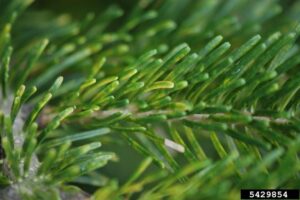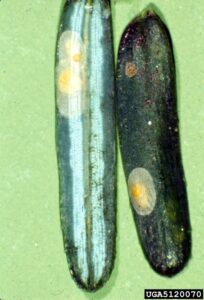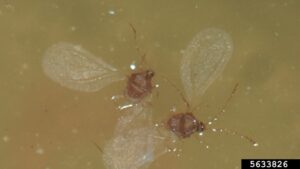Christmas tree growers have been struggling with an invasive scale pest called Cryptomeria scale (Aspidiotus cryptomeriae), which is a serious pest of conifers. The scales infest the undersides of the needles and extract plant juices with their piercing-sucking mouthparts. Economic losses are due to the unsightly yellow discoloration and needle drop that occurs from the insect feeding (Fig. 1).
- Fig. 1. Yellowing mottling damage due to scale feeding. Image: Brian Kunkel, University of Delaware.
Life cycle. Cryptomeria scale has two generations per year. It overwinters as second-instar nymphs on the undersides of the needles, and in spring (March-April) the nymphs begin feeding again and continue development. They reach maturity by late spring. The adult females are flightless and remain stationary. They have a “fried egg” appearance of a white oval shape with a yellow center (Fig. 2). The adult males are alate, meaning they have wings (Fig. 3). Males fly in the summer, typically in July. They will mate with the females and die shortly after. The females lay eggs in the weeks following the mating flight. Egg hatch occurs around late August. These newly-hatched nymphs are called “crawlers”, because they are mobile and will disperse across the plant to find a new spot to settle and feed. Cryptomeria scale nymphs may not move very far from the female; many settle close to the female. The crawler stage is over by early September, when most have established a feeding site. They will develop through the fall into second-instars and overwinter until the following spring.
- Fig. 2. Adult female Cryptomeria scale. Image: United States National Collection of Scale Insects Photographs, USDA Agricultural Research Service.
- Fig. 3. Alate adult males. Image: Blake Williams.
Management. Scout for the scale in the late winter when the scales are overwintering and prune infested branches, or remove the entire tree if heavily infested. Lady beetles and parasitic wasps will feed on Cryptomeria scale, so use biorational insecticides to maintain populations of beneficial insects which help control Cryptomeria scale and other pests.
Since Cryptomeria scales are armored scales, horticultural oils are recommended instead of insecticidal soaps for effective management (Quesada et al. 2017). Apply oils before bud break to target overwintering scales. Make sure to saturate the needles fully, especially the undersides of the needles, to smother the scales. For a more aggressive solution, dinotefuran can be applied for control of Cryptomeria scale. Basal bark applications of dinotefuran applied just after bud break were shown to significantly reduce scale populations and actually improved the rate of parasitism from parasitic wasps (Cowles 2010).
Not sure if you Cryptomeria scale or something else? Reach out to the Plant Pest and Diagnostics Lab for identification services!
References
Cowles, R. S. (2010). Optimizing a Basal Bark Spray of Dinotefuran to Manage Armored Scales (Hemiptera: Diaspididae) in Christmas Tree Plantations. Journal of Economic Entomology, 103(5), 1735–1743. doi.org/10.1603/EC10077
Quesada, C. R. & Sadof, C. S. (2017). Efficacy of Horticultural Oil and Insecticidal Soap against Selected Armored and Soft Scales. HortTechnology, 27(5), 618–624. doi.org/10.21273/HORTTECH03752-17
Susan Scheufele and Nicholas Brazee (2014). Cryptomeria scale. UMass Extension Landscape, Nursery and Urban Forestry Program. umass.edu/agriculture-food-environment/landscape/fact-sheets/cryptomeria-scale


